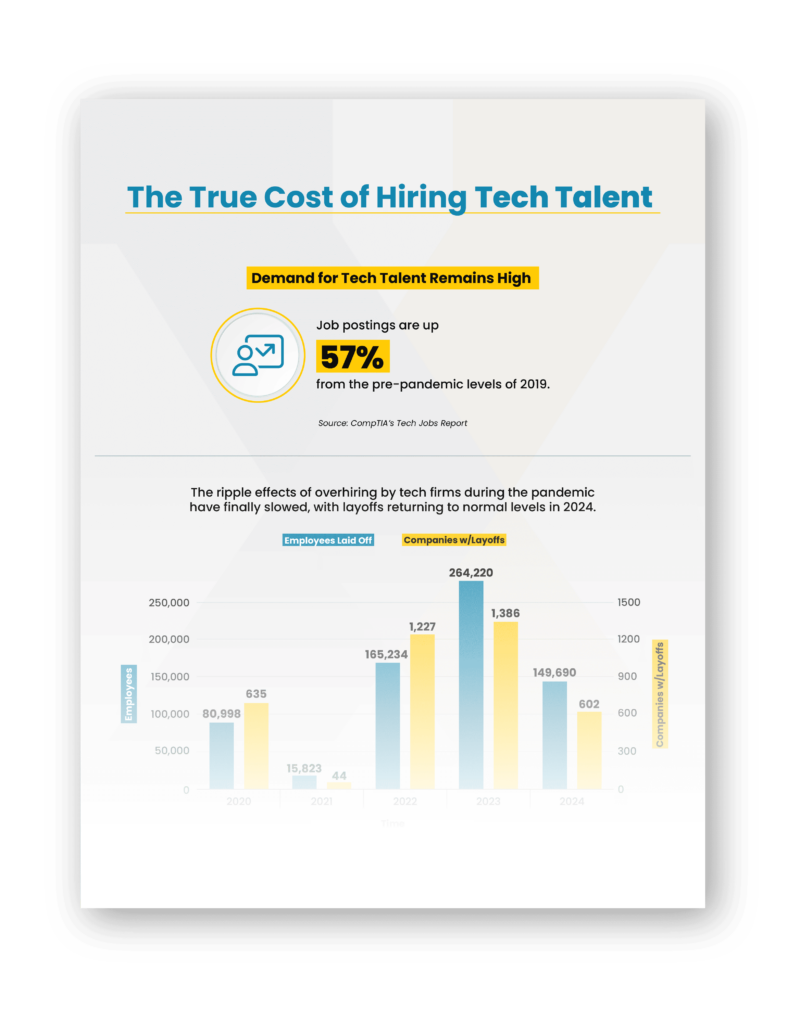The complexity of IT projects is escalating – at the same time increasing customer expectations and market competition force businesses to respond faster than ever to changing customer needs. In response, forward-thinking IT teams are turning to Hybrid Project Management: combining the best practices of the leading delivery methods to meet business needs efficiently and effectively.
Traditionally, an IT project team follows a Waterfall Project Management approach – with project managers mapping out distinct, sequential phases. Each project team works linearly toward a set goal with little deviation, starting a new project phase only after the previous one is completed.
Software teams started the shift toward Agile’s iterative process, delivering via a series of short development sprints that enable consistent feedback, adjustment, and wins throughout the development lifecycle. Market conditions demanding faster changes and response pushed Agile Project Management into the mainstream, with 71% of U.S. enterprises now following its methodology.
But neither method is perfect for every project and organization. Many IT leaders are realizing that a hybrid approach combining the robust structure, detailed planning, and clarity of Waterfall Project Management with the adaptability, speed, and efficiency of the Agile methodology delivers the best results.
Read on to discover the benefits of Hybrid Project Management, as well as smart tips for leveraging the strengths of Waterfall and Agile methodologies while navigating potential weaknesses.
Waterfall vs. Agile Project Management: Pros and cons
Waterfall Project Management
PROS
- Clearly defined project phases create more predictable work, timelines, and task visibility.
- Well-known in the project management world, creating high comfort levels for IT teams.
- Detailed, upfront planning makes it easier to identify issues and risks. It’s also easy for a project manager to measure progress with a traditional Waterfall approach because the full scope of work is known in advance.
- Well-suited to projects with low uncertainty.
CONS
- Extensive, detailed documentation and excessive meetings to coordinate work/update status bog down project managers and teams.
- Minimal customer collaboration increases the risk of misunderstood requirements, low customer satisfaction, and rework.
- Takes more time to deliver value to customers.
- Continuous improvement is more difficult to achieve within a rigid structure.
Agile Project Management
PROS
- Fosters robust communication and collaboration with customers and within project teams, creating greater potential for customer satisfaction. Constant feedback enables regular adjustments during each project phase that ensure customer needs are met.
- Better transparency and visibility into work make it easier to identify problems early.
- Well-suited to projects without well-defined scopes or new, unknown products or services.
CONS
- Less documentation and upfront planning make it harder to identify risks when the project starts.
- Harder to predict project costs, time, and resource needs.
- While the better collaboration of the Agile approach surfaces diverse viewpoints, it also risks slowing down the pace of work and devolving into decision by committee.
- A drastic shift from traditional project management, Agile-experienced Project Management teams are needed to maximize benefits, minimize confusion, and choose the right Agile approaches (Scrum, Lean, Exploratory) for a project.
3 big benefits of Hybrid Project Management
Of course, blending two different project management methods into a hybrid approach can be tricky, which begs the question: Wouldn’t it be easier to just pick one?
Here’s why Hybrid Project Management is worth the effort:
1. Flexibility to combine the best of the Agile and Waterfall methodologies.
Hybrid Project Management allows you to tailor your approach to the specific needs of each particular project and team. Since no hard and fast rules apply, you can experiment until you blend the aspects of each project management method that truly fit your organization’s skills, culture, and project goals.
2. Optimized structure for your entire project.
Predefined sprints enable quick, predictable delivery and accurate cost estimates, while still allowing project managers and teams to pivot and make decisions quickly.
3. Better clarity for project teams and customers.
Hybrid Project Management offers the greatest clarity into project plans, status, and responsibilities.
For instance, a project manager can draw on the traditional Waterfall approach to create a clear roadmap that defines roles and responsibilities, deadlines, and expectations for hybrid projects. At the same time, the project manager can incorporate an Agile Project Management approach that seeks stakeholder feedback from start to finish – increasing communication, minimizing misunderstandings, and ensuring project goals are met.
Dashboards improve clarity even more with instant access to real-time status and next steps.

8 smart tips for effective Hybrid Project Management
1. Start with a clear vision of your hybrid strategy.
Crystallizing a clear vision at the start is vital to shaping an effective Hybrid Project Management approach. Fully understanding what Waterfall and Agile Project Management methodologies bring to the table helps you leverage their strengths – digging into what you like and don’t like about their processes and subprocesses.
Deep understanding of project requirements is also key to applying Hybrid Project Management successfully. For instance, do parts of the project require strict deliverables? Are there areas that aren’t firmly established or might change as the project progresses?
A clear vision ensures implementation tools support your hybrid approach as well, including automation, collaboration tools, and the right project management software.
2. Combining Agile execution with Waterfall planning can deliver the best project outcomes.
The detailed planning of the Waterfall approach creates a clear understanding of project scope and activities, with robust processes and tools for identifying important stakeholders, building a work breakdown structure (WBS), managing risk, and more.
Following an Agile process for execution optimizes results by re-evaluating after each sprint, improving teamwork and communication, and providing the flexibility to quickly address emergent issues and shifting priorities.
3. Involve key stakeholders from start to finish.
Waiting until the end of a project to present products or services to the customer is the biggest pitfall of the Waterfall approach. Engaging key stakeholders throughout a development cycle is vital to ensuring project plans, decisions, and results meet their strategic goals and requirements.
Close collaboration also increases the chance of finishing project phases on time and within budget. For instance, encouraging customer feedback in sprint reviews helps avoid unnecessary rework amidst changing business needs.
That doesn’t mean every stakeholder should be involved in every facet of project delivery.
Effective Hybrid Project Management starts by identifying critical stakeholders and their project roles. The Waterfall methodology offers helpful tools for building stakeholder maps that compare levels of authority against the need for active involvement, incorporating meeting plans and communication frequency for each individual and group.
4. Create self-service destinations to minimize status meetings/inquiries.
Effective Hybrid Project Management incorporates well-structured and widely accessible dashboards, radiators, and charts – providing simple self-service destinations for team members and other stakeholders seeking up-to-date insights.
For instance, project management dashboards let the project manager understand project status at a glance. They offer real-time, 360-degree views of progress and performance as well as the ability to drill down into specific areas like task status, budget, and risks.
Secure, shared repositories like Microsoft SharePoint also can streamline Hybrid Project Management – creating a centralized location for storing and managing documents, communicating with team members, assigning tasks and deadlines, tracking progress, and collaborating in real time.
5. Keep team members aligned with daily standups.
Replace lengthy, boring status meetings with Agile’s daily stand-ups, offering a quick, dynamic way for Hybrid Project Management teams to stay aligned, focused, and on-task. Contributors have 15 minutes to discuss project status at a high level – sharing critical information, openly discussing issues, and ensuring accountability for project tasks.
Daily standups also enhance team dynamics, driving transparent communication and collaboration for Hybrid Project Management teams.
6. Drive continuous improvement with Agile retrospectives.
While post-mortems provide full-scope reviews at the end of a project, retrospectives favored by the Agile methodology drive continuous feedback and improvement throughout the project lifecycle. By discussing what went well and what didn’t after every sprint, teams can learn from their success and generate actionable ideas for improving raised issues in the next phase.
7. Adopt Lean practices to eliminate waste.
A hybrid approach that incorporates Lean Project Management enables teams to deliver faster – managing workflow efficiently and maximizing value for customers.
For instance, Waterfall requires heavy documentation that can overwhelm stakeholders and project teams. A Hybrid Project Management methodology with an effective Lean approach involves minimal documentation, producing only what is necessary to satisfy customers, maintain project stability, and support audits and organizational memory.
8. Train your team in your hybrid approach.
Since the Hybrid Project Management methodology involves project-specific customization, effective training is vital to ensuring everyone understands the approach and has the necessary skills for success. Don’t assume a project team following a hybrid approach has innate understanding of every aspect of Waterfall and Agile Project Management methodologies.
To ensure buy-in with your hybrid approach, it’s also wise to include a brief overview of the annoyances, problems, and inefficiencies the new Hybrid Project Management methodology will resolve. And of course, don’t forget to mention the better results teams can expect.
Achieve Hybrid Project Management success with the right digital transformation partner
For all the times you thought, “This approach would be amazing if only …”, Hybrid Project Management offers the perfect solution for delivering quality projects.
But building and implementing a Hybrid Project Management approach isn’t easy – and there’s no magic recipe for success. Nearly half of Agile projects fail due to a lack of experience with Agile methods. Waterfall projects only report a 49% success rate.
Not surprisingly, nearly 80% of enterprises are outsourcing IT projects like software and app development, according to Deloitte’s 2022 Global Outsourcing Survey – realizing the critical need for tools, best practices, experience, and expertise they don’t possess to run a significant change program and guarantee success.
Quality digital transformation partners are experts at optimizing a Hybrid Project Management approach for your specific project needs, blending the right mix of tools and techniques for seamless execution. They also have the knowledge and flexibility to make course corrections along the way, regularly evaluating and adapting their hybrid approach to ensure the best outcomes.
Enterprises that hire nearshore partners beat the IT labor shortage as well by accessing a deep pool of skilled resources in similar time zones that maximize collaboration opportunities.
The right digital transformation partner empowers IT teams to combine different project management methodologies into something better – maximizing results, minimizing expenses, and reaching project goals faster and more effectively.
Want to learn more about using Hybrid Project Management to maximize the success of your IT projects? Schedule a consultation with our Digital Transformation experts today! You can also read our blogs for other digital transformation tips and strategies.





